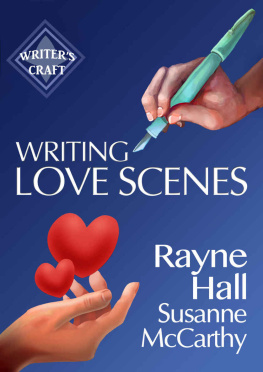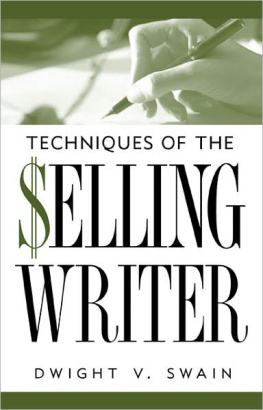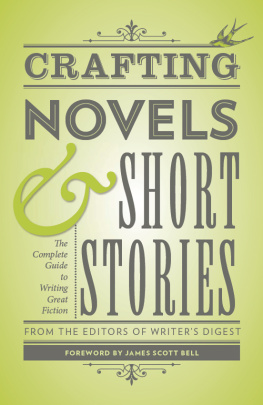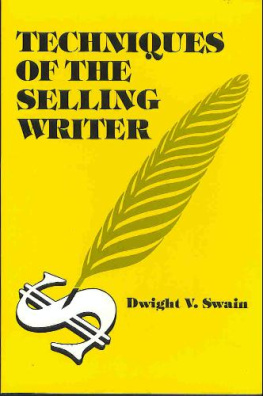TECHNIQUES
OF THE
SELLING
WRITER
By
DWIGHT V. SWAIN
UNIVERSITY OF OKLAHOMA PRESS NORMAN

2800 Venture Drive
Norman, Oklahoma 73069
www.oupress.com
Copyright 1965 by Dwight V.Swain. Assigned 1973 to the University of Oklahoma Press,Norman, Publishing Division of the University.Manufactured in the U.S.A. Paperback edition published 1981.
All rights reserved. No part of this publication may be reproduced, stored in a retrieval system, or transmitted, in any form or by any means, electronic, mechanical, photocopying, recording, or otherwiseexcept as permitted under Section 107 or 108 of the United States Copyright Act without the prior permission of the University of Oklahoma Press.
For information about permission to reproduce selections from this book, write to Permissions, University of Oklahoma Press, 2800 Venture Drive, Norman, Oklahoma 73069 or email
ISBN 978-0-8061-1191-9 (paperback : alk. paper)
ISBN 978-0-8061-8657-3 (ebook : mobipocket)
ISBN 978-0-8061-8667-2 (ebook : epub)
This eBook was converted from the original source file by a third-party vendor. Readers who notice any formatting, textual, or readability issues are encouraged to contact the publisher at .
For Joye,
who cared
Foreword
Be warned in advance that we here shall deal with one topic and one only: writing.
By writing, I mean the process of creation as applied to fiction... the conjuring up of original stories out of the nether reaches of your mind.
My purpose is to help would-be fiction writers learn how to carry out this process less slowly and less painfully. The devices set forth all are used, consciously or otherwise, by selling writers.
This is because said devices have proved effective in making stories enjoyable and/or enticing to readers. The selling writer, as a commercially-oriented professional, cant afford to write copy that isnt enjoyable and/or enticing.
Since theyre primarily tools, these techniques have little bearing on literary quality or the lack of it. No writer uses all of them. No writer can avoid using some of them. How well they serve will depend on you yourself.
They are, in brief, tricks and techniques of the selling writer.
Theyre all this book has to offer.

It would be fitting, at this point, to give personal credit to all the people who helped show me the literary ropes in years gone by. But such a list would of necessity run too long, for it would include each and every writer of each and every book and magazine I ever read... plus the many friends who taught me about assorted joys and the enemies who taught me about trouble... plus the editors like Ray Palmer and Howard Browne and Bill Hamling who pushed and poked at me and bought my stories... plus such colleagues as Ned Hockman (who, though Ive worked with him on fifty fact films, still can show me new tricks about how to put together a motion picture) and Foster-Harris (who knows all that there is to know about plotting and about how to be an inspiration) and the late great Walter S. Campbell, founder with Foster-Harris of the University of Oklahomas courses in Professional Writing... plus, above all, my students, who for a dozen years now have backed me into corners and made me figure out ways to say things so that they make sense to someone who hasnt already sold a million words of copy.
Truly, one and all, Im grateful.
D.V.S.
NORMAN, OKLA.
Contents
CHAPTER 1
Fiction and You
A story is experience translated into literary process.
You need to know only four things in order to write a solid story:
how to group words into motivation-reaction units;
how to group motivation-reaction units into scenes and sequels;
how to group scenes and sequels into story pattern;
how to create the kind of characters that give a story life.
This book tells you how to do these things; these, and many, many more. In detail: step by step. The tricks are here... the tools, the techniques, the devices. Youll find them in .
Are these things hard to learn?
Not at all.
At least, not if you take the job a step at a time, so that you understand why you do each thing, as well as how.
Then why do so many people find it difficult to learn to write?
They fall into traps that slow them down and hold them back.
Eight traps, specifically:
1. They take an unrealistic view.
2. They hunt for magic secrets.
3. They try to learn the hard way.
4. They refuse to follow feeling.
5. They attempt to write by rules.
6. They dont want to be wrong.
7. They bow down to the objective.
8. They fail to master technique.
Every one of these traps is a major hazard. Therefore, before we get down to specific skills, lets consider each in detail.
Reality and the writer
Can you learn to write stories?
Yes.
Can you learn to write well enough to sell an occasional piece?
Again yes, in most cases.
Can you learn to write well enough to sell consistently to Redbook or Playboy or Random House or Gold Medal?
Now thats another matter, and one upon which undue confusion centers.
Writing is, in its way, very much like tennis.
Its no trick at all to learn to play tennisif you dont mind losing every game.
Given time and perseverance, you probably can even work yourself up to where Squaw Hollow rates you as above-average competition.
Beyond that, however, the going gets rough. Reach the nationals, win status as champion or finalist, and you know your performance bespeaks talent as well as sweat.
So it is with writing. To get stories of a sort set down on paper; to become known as a leading Squaw Hollow writer, demands little more than self-discipline.
Continued work and study often will carry you into American Girl or Mens Digest or Real Confessions or Scholastic Newstime.
But the higher you climb toward big name and big money, the steeper and rougher your road becomes.
At the top, its very rough indeed. If you get there; if you place consistently at Post or McCalls or Doubleday, you know its because you have talent in quantity; and innate ability that sets you apart from the competition.
Now this doesnt seem at all strange to me. The same principle applies when you strive for success as attorney or salesman or racing driver.
Further, whatever the field, no realist expects advance guarantees of triumph. You cant know for sure how well youll do until you try. Not even a Ben Hogan, a Sam Snead, or an Arnold Palmer made a hole-in-one his first time on the links. To win success, you first must master the skills involved. A pre-med student isnt called on to perform brain surgery.
Goodthat is, salablestories presuppose that you know how to write, how to plot, how to characterize, how to intrigue readers; how to make skilled use of a hundred tools.
A book like this one shows you these basic tricks and techniques.
What you do with those devices, however; how well you use them, is a thing that must ever and always depend on you: your intelligence, your sensitivity, your drive, your facility with language.
Your talent.
But before you shrug and turn aside, remember just one point: In writing, more than in almost any other field, initiative is the key. Ernest Hemingway had to write a first line and a first story too. So did John Steinbeck and Edna Ferber, Faith Baldwin and Pearl Buck and Frank Yerby and Erle Stanley Gardner. Each followed the same path. Each linked desire to knowledge, then took his chances.
Next page










